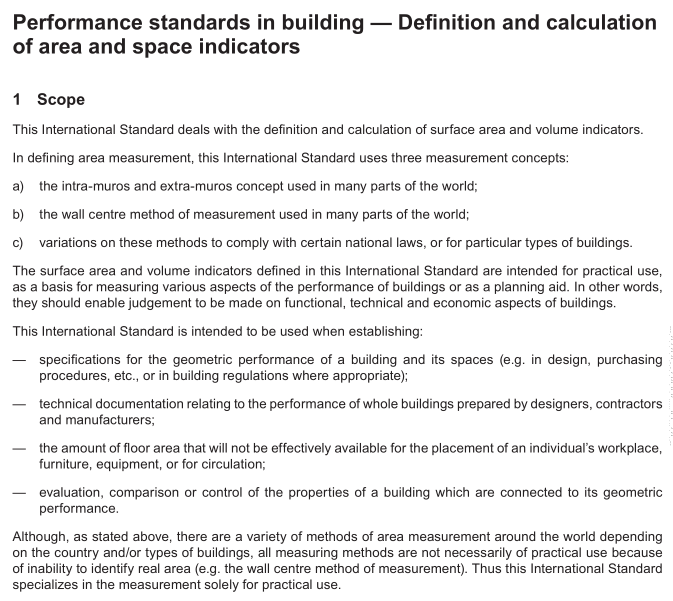ISO 9836 pdf download

ISO 9836 pdf download Performance standards in building — Defnition and calculation of area and space indicators
5.1.4Ilntra-muros area
5.1.4.1 The intra-muros area is the total floor area (5.1.3) less the floor area taken up by the external walls(floor area of the building envelope).
5.1.4.2 The intra-muros area is determined separately for each floor level. The calculation principlesestablished for the total floor area (5.1.3) and for the area taken up by the external walls (5.1.6) apply equially.The intra-muros area is obtained by subtracting the area taken up by the external walls from the total floor area.
5.1.4.3 The intra-muros area includes the net floor area (5.1.5) and the area taken up by the internal walls.
5.1.5 Net floor area
5.1.5.1 The net floor area is the area between (within) the enclosing elements (see also 5.1.3.2).
5.1.5.2 The net floor area is determined separately for each floor level and is sub-divided according to 5.1.3.1.ltis calculated from the clear dimensions of the finished building at floor height, excluding skitings, thresholds,etc.Covered floor areas that are not enclosed, or only partally enclosed and have no enclosing elements areasmentioned in 5.1.3.1 b)]are determined by the vertical projection of the outer limit of the covering components.Areas with varying storey height within one floor level (e.g. large halls and auditoria) are calculated separately.
5.1.5.3 Also included in the net floor area are demountable components such as partitions, pipes and ducts.
5.1.5.4 The floor areas of structural elements, door and window recesses,and niches to recesses in theelements enclosing the area are not included in the net floor area.
5.1.5.5 The net floor area is divided into:
-usable area(5.1.7);
-services area (5.1.8); and-circulation area(5.1.9).
5.1.6Area of structural elements
5.1.6.1 The area of structural elements is the area within the total floor area (on a horizontal section at floorlevel) of the enclosing elements (e.g.external and internal load-bearing walls) and the area of columns, pillars,piers, chimneys, partitions, etc., which cannot be entered (see Figure 1).
5.1.6.2 The area of structural elements is determined separately for each floor level and, where necessary,is sub-divided according to 5.1.3.1. lt is calculated from the dimensions of the finished building at floor heightexcluding skirtings, thresholds, plinths, etc.
5.1.6.3 Also included in the area of structural elements are the floor areas of door recesses, and recesses andniches in the enclosing elements (see 5.1.5.4).This is in accordance with 5.1.3.2.
5.1.6.4 The area of structural elements may also be calculated as the difference between the total floor area(5.1.3) and the net floor area(5.1.5).
5.1.7Usable area
5.1.7.1 The usable area is that part of the net floor which corresponds to the purpose and use of the building(see Figure 1).
5.1.7.2 The usable area is determined separately for floor level and is sub-divided according to 5.1.3.1.
5.1.7.3 Usable areas are classified according to the purpose of the building and the use to which they are put;they are usually divided into main usable areas and subsidiary usable areas.
The classification into main usable area and subsidiary usable area is dependent on whether the purposeof the space is an integral component of the primary purpose(s) of the building, or in support of the primarypurpose(s) of the building.
Below is a sample list of such purposes. For more detail, see also Tables 1 and 2 of ISO 6241:1984.
a) Transport (of people, goods, fuids, electricity, etc.).
b) Industry (manual work, production, manufacture, agriculture, experimentation, etc.).
c) Offce, commerce (study, writing, drawing, retail or wholesale selling, book-keeping, etc.).
d) Medical care (examination, treatment, operations, etc.).
e) Recreation (gymnastics, swimming, play, dance, etc.).
f) Culture (worship, education, meeting, etc.).
g) Housing (sleeping, dwelling, etc.).
h) Circulation (walkway, corridor, stairway, etc.).
i) Catering (cooking, consumption, etc.).
j) Hygiene (bathing, toilet functions, etc.).
k) Cleaning, maintenance (laundry, janitorial, repair, etc.).
l) Storage (of goods, clothing, foods, etc.).
m) Service (power plant, building operations, guard post, etc.).
n) Other.









